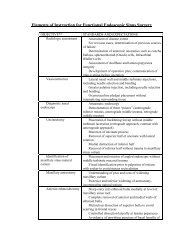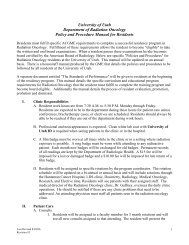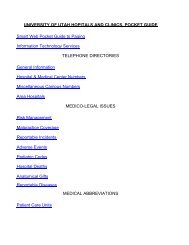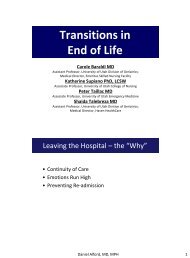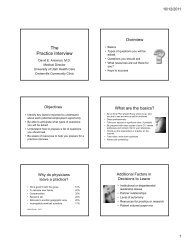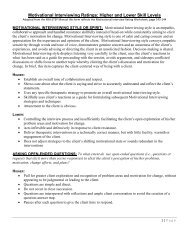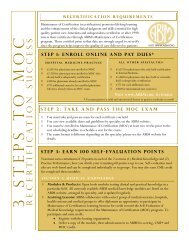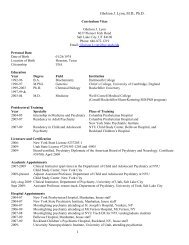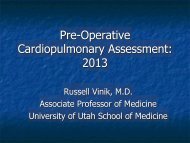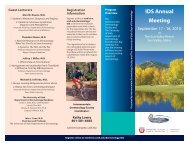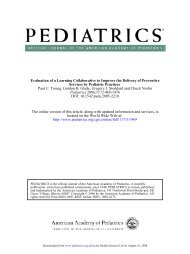Acute Diarrhea Evaluation in Primary Care Acute Diarrhea luation in ...
Acute Diarrhea Evaluation in Primary Care Acute Diarrhea luation in ...
Acute Diarrhea Evaluation in Primary Care Acute Diarrhea luation in ...
Create successful ePaper yourself
Turn your PDF publications into a flip-book with our unique Google optimized e-Paper software.
<strong>Acute</strong> <strong>Diarrhea</strong><br />
<strong>Eva<strong>luation</strong></strong> <strong>in</strong> <strong>Primary</strong> <strong>Care</strong><br />
Robert F. Miller, M.D.<br />
28 November, 2007
Def<strong>in</strong>ition— —”diarrhea”<br />
• Patient: stools too frequent or too soft<br />
• <strong>Care</strong>giver: stools have too much water<br />
• Patient consideration lead to visit and<br />
• is addressed <strong>in</strong> treatment<br />
• <strong>Care</strong>giver def<strong>in</strong>ition leads to decision for<br />
• eva<strong>luation</strong> and treatment
Def<strong>in</strong>ition— —”<strong>Acute</strong>”<br />
• Patient: change <strong>in</strong> bowel frequency or<br />
consistency<br />
<strong>Care</strong>giver: new disease<br />
requires careful consideration of prior<br />
bowel pattern
Developed vs. undeveloped<br />
countries<br />
• High prevalence of serious <strong>in</strong>fectious<br />
• disease <strong>in</strong> underdeveloped areas<br />
• In developed countries, pa<strong>in</strong>, fear,<br />
• explanations, & missed work<br />
• Most diarrhea <strong>in</strong> developed world<br />
• unexpla<strong>in</strong>ed
Initial <strong>Eva<strong>luation</strong></strong><br />
• <strong>Eva<strong>luation</strong></strong> primarily cl<strong>in</strong>ical<br />
– Low yield of diagnostic tests<br />
– Most illnesses selflimited limited<br />
– Deal with reason(s) for patient visit<br />
– Exclude chronic diarrhea, with flare<br />
– Consider causes not directly gastro<strong>in</strong>test<strong>in</strong>al<br />
– runner’s diarrhea; medication; colon<br />
– ischaemia
Initial <strong>Eva<strong>luation</strong></strong><br />
• Degree of illness of patient:<br />
• hydration<br />
• septic or toxic<br />
• systemic disease<br />
• consider therapeutic dilemmas:<br />
• antibiotics; antidiarrheal agents<br />
• how best to rehydrate—oral vs IV<br />
• duration of diarrhea
Initial eva<strong>luation</strong>diagnostic<br />
possibilities<br />
• Exposure history—epidemics; others<br />
• who are ill<br />
• Outdoor or unclean water exposure<br />
• Food exposure; time s<strong>in</strong>ce exposure;<br />
• others who became ill<br />
• Enclosed space/nurs<strong>in</strong>g home/nursery<br />
• Nutrition<br />
• travel
Types of diarrhea<br />
• Watery<br />
• secretory<br />
• malabsorption<br />
• periumbilical pa<strong>in</strong><br />
• Inflammatory (colitis implied)<br />
• blood<br />
• pa<strong>in</strong>(hypogastric)<br />
• tenesmus<br />
• Motility<br />
• urgency<br />
• pa<strong>in</strong> (associated with passage of stool)
Food Poison<strong>in</strong>g Syndromes<br />
• Preformed tox<strong>in</strong><br />
• emesis, with or without diarrhea<br />
• immediate (26 hr) symptoms<br />
• Staph aureus<br />
• Bacillus cereus (type I)<br />
• Conta<strong>in</strong>errelated related syndromes (esp. copper)<br />
• Anisakiasis (raw herr<strong>in</strong>g)(larvae are toxic)
Food Poison<strong>in</strong>g Syndromes<br />
• Tox<strong>in</strong> formed <strong>in</strong> GI tract<br />
• delay <strong>in</strong> symptoms (c. 24 hr)<br />
• Clostridium perfr<strong>in</strong>gens<br />
• Bacillus cereus (type II)<br />
• Foodacquired bacterial <strong>in</strong>fections<br />
• Salmonella<br />
• Viral<br />
• E.coli
GI disease not related to food<br />
• Waterborn pathogens<br />
• giardia; cryptosporidium; cyclosporosis<br />
• enterotoxic E.coli (traveller’s diarrhea)<br />
• cholera<br />
•<br />
• Amoeba<br />
• Sexually transmitted colon disease<br />
• gonorrhea; HSVII; LGV
Test<strong>in</strong>g <strong>in</strong> acute diarrhea<br />
• “expensive, uncomfortable, low yield;<br />
• labor <strong>in</strong>tensive”<br />
• for acute diarrhea, yield
Gastroenteritis syndromes<br />
• Emesis and diarrhea<br />
• 80% food related or oralfecal (<strong>in</strong>fants)<br />
• Secondary transmission; carrier of<br />
• <strong>in</strong>fective particles for 2 weeks<br />
• Prognosis worse <strong>in</strong> <strong>in</strong>fants and elderly<br />
• Cultures if publichealth concerns<br />
• (E coli; salmonella; shigella, plus<br />
• hepatitis A)<br />
• test<strong>in</strong>g for research or epidemiology<br />
• Serology for persons with asymptomatic disease
Major causes of viral gastroenteritis<br />
• Calicivirus group<br />
• 90% of epidemic gastroenteritis)<br />
• <strong>in</strong>cludes Norwalk agent, sapovirus<br />
• (children), norovirus<br />
• Rotavirus—primarily <strong>in</strong>fants<br />
• Adenovirus types 40 & 41<br />
• Astrovirus<br />
• (CMV <strong>in</strong> immunosuppressed)
Calicivirus<br />
• 90% of epidemic gastroenteritis<br />
• Norwalk, Saporo, etc virus<br />
• =norovirus<br />
• Cannot grow virus <strong>in</strong> cell culturestudy by<br />
• EIA for antibody and stool antigen,<br />
• or more recently by RTPCR<br />
• Immunity shortterm term and genotype<br />
• specific—repeat <strong>in</strong>fections; vacc<strong>in</strong>e<br />
• will be problematic (attempts underway)<br />
• Prolonged excretion of virus; secondary cases
Calicivirus (cont<strong>in</strong>ued)<br />
• Highly <strong>in</strong>fectious—fecal fecaloral,<br />
approxomately 20% may be respiratory<br />
• Epidemicsàhumanà àseafood/shellfishà<br />
• multiple humans<br />
• Incubation 2448 hr<br />
• Little immunity, multiple stra<strong>in</strong>s<br />
• Difficult to remove from (clean) surfaces
Rotavirus<br />
• Major illness <strong>in</strong> very young. Nevertheless,<br />
• about 1/5 <strong>in</strong> older patients, with<br />
• mortality <strong>in</strong> very old<br />
• Multiple stra<strong>in</strong>s, partial immunity after<br />
• <strong>in</strong>fection. Vacc<strong>in</strong>e reduced <strong>in</strong>cidence<br />
• but was withdrawn<br />
• Villus <strong>in</strong>jury not related to severity of<br />
• diarrhea<br />
• DiagnosisEIA or RT PCR<br />
• Treatment:rehydration,?YGlobul<strong>in</strong>,?probiotics
Pathogenesis of viral<strong>in</strong>duced<br />
diarrhea<br />
• Inflammation m<strong>in</strong>imal, or patchy<br />
• Involves upper 2/3 of villus membrane<br />
• (brush border)<br />
• Rotavirus best studied;<br />
• NSP4 prote<strong>in</strong>—viral plus enterocyte<br />
• contribution—viruscell cell <strong>in</strong>teraction. Increase <strong>in</strong> <strong>in</strong>tra<br />
• cellular calcium promotes chloride secretion.<br />
• disaccharidases <strong>in</strong>hibited<br />
• SCLT1 <strong>in</strong>hibited (=malabsorption of CHO)<br />
• epithelial cell cytoskeleton altered (distortion of<br />
• chemical and osmotic gradients)<br />
• cytok<strong>in</strong>elike peptides (from host as well as virus)
Traveller’s diarrhea<br />
• Usually 36 days after arrival <strong>in</strong> new<br />
• country<br />
• Central America>Africa>SE Asia>Asia<br />
• Most from entertoxigenic E.coli<br />
• Rotavirus accounts for 10%<br />
• Clostridium difficile also common<br />
• Parasites (except giardia) rare<br />
• 5 days – 3 weeks is usual course<br />
• High <strong>in</strong>cidence of post<strong>in</strong>fectious FBDz
Functional gastro<strong>in</strong>test<strong>in</strong>al<br />
disorders<br />
• May be <strong>in</strong>duced by otherwise mild<br />
gastroenteritis. Most resolve eventually<br />
• Rome criterion<br />
• Most prevalent explanations: change <strong>in</strong><br />
• Flora; mild E.coli; different foods; different<br />
daily rout<strong>in</strong>es, <strong>in</strong>clud<strong>in</strong>g different<br />
bathrooms<br />
• Most common cause of prolonged<br />
diarrhea after travel(&after a mission)
Foodrelated gastro<strong>in</strong>test<strong>in</strong>al<br />
<strong>in</strong>fections<br />
• Gastroenteritis syndrome be a m<strong>in</strong>or or<br />
• major manifestation of <strong>in</strong>fection<br />
• Inoculum size (degree of <strong>in</strong>fectivity)<br />
• variable: low for viral illness, shigella,<br />
• and E.coli<br />
• high for salmonella, probably high for<br />
• campylobacter<br />
• Many bacterial illnesses waterborn<br />
• Most parasitic illnesses waterborn
Types of <strong>in</strong>fectious (nonviral)<br />
• Secretory<br />
• tox<strong>in</strong> related<br />
diarrhea<br />
• Inflammatory<br />
• locally active tox<strong>in</strong> (shiga);direct <strong>in</strong>vasion<br />
• may have systemic tox<strong>in</strong> as well<br />
• (motilityrelated factors)
salmonella<br />
• Most common foodborn <strong>in</strong>fection<br />
• Attack rates highest <strong>in</strong> those 75<br />
• Predispos<strong>in</strong>g conditions: hemolytic anemia<br />
• (esp sickle cell disease; achlorhydria<br />
• (esp after gastric surgery);prior antibiotics<br />
• immunosuppression; schistosomaisis<br />
• Food source often from farm workers<br />
• Domestic animals & pets as carriers
Salmonella (cont<strong>in</strong>ued)<br />
• Dist<strong>in</strong>ct cl<strong>in</strong>ical syndromes:<br />
• gastroenteritis: <strong>in</strong>cubation ½1 day<br />
• duration 34 days; N&V; RLQ pa<strong>in</strong><br />
• colitis: bloody diarrhea; fever. May<br />
• have sepsis or toxic megacolon.<br />
• 1 week – 3 mo illness<br />
• bacteremia (esp <strong>in</strong> AIDS pts)<br />
• (typhoid fever) S. typhimurium<br />
• focal <strong>in</strong>fection/abscess<br />
• carrier state (0.20.6%) 0.6%)
Salmonella (cont<strong>in</strong>ued)<br />
• Treatment:<br />
• for acute gastroenteritis syndrome<br />
• (antibiotics debated)<br />
• for colitisantibiotics usually suggested<br />
• for sepsis—ampicill<strong>in</strong> if sensitive<br />
• for focal <strong>in</strong>fection—ampicill<strong>in</strong> or TMS<br />
• for AIDS, sickle, etc—ampicill<strong>in</strong>, etc<br />
• for carrier?cholecystectomy; ?noth<strong>in</strong>g<br />
• if schistosomaisis?praziquantl
E.Coli alphabet<br />
• Enteropathogenic (EPEC)<br />
• newbornsàAsians;<br />
• localized adherence(eaeA gene cluster)<br />
• Enterotoxigenic(ETEC)<br />
• traveller’s diarrhea; heatlabile &stable<br />
• tox<strong>in</strong><br />
• Entero<strong>in</strong>vasive(EIEC)— —colitis (Asia)<br />
• Enterohemorrhagic(EHEC)O157:H7<br />
• Enteroaggregative(EAggEC)?any dz from it?<br />
• Diffusely adher<strong>in</strong>g E. coli(DAEC) (France)
E.coli O157:H7<br />
(Enterohemorrhargic E.coli)<br />
• 35 days <strong>in</strong>cubation; diarrhea>blood <strong>in</strong><br />
• 1à2 days. Pa<strong>in</strong> <strong>in</strong> 1/3, usually after<br />
• blood appears. <strong>Diarrhea</strong> lasts 38 days<br />
• Multiple food can carry organism; food works, wild<br />
• animal also (water may be a source)<br />
• Low <strong>in</strong>fective doseà10% secondary<br />
• spread; ?isolation; identify others exposed<br />
• HUS usually if
shigella<br />
• Ubiquitous organism; <strong>in</strong>vasive (colon and<br />
• term<strong>in</strong>al ileum; food and personto<br />
• person spread; moderate attack rate<br />
• 13 week illness; pa<strong>in</strong> and diarrhea may<br />
• preceed blood<br />
• Extra<strong>in</strong>test<strong>in</strong>al complications<br />
• Hydration; systemic antibiotics (ampicill<strong>in</strong>)<br />
• Avoid antimotlity drugs
Campylobacter jejuni<br />
• Common; rarely asymptomatic but disease<br />
• may be mild<br />
• Infected food; animals as source<br />
• 13 day usual <strong>in</strong>cubation period<br />
• Antibiotics do not shorten illness
Other <strong>in</strong>fectious<br />
diarrheas<br />
• Vibrio – usually secretory darrhea<br />
• cholera<br />
• biotype 01: classic & El Tor<br />
• tox<strong>in</strong>s: activate CAMP; ZOT<br />
• parahaemolyticus”Kanagawa +”<br />
• cholera Non01 – (esp V. vulnificus)<br />
• vacc<strong>in</strong>es only partially and briefly<br />
• effective<br />
• Yers<strong>in</strong>ia enterocolitica
Clostridium difficile<br />
• No longer “just” a nosocomal <strong>in</strong>fection<br />
• Inflammatory diarrhea<br />
• A small but significant number have no<br />
• antibiotic exposure<br />
• Humantohuman spread (hand wash<strong>in</strong>g)<br />
• One of he causes of traveller’s diarrhea<br />
• Usually requires treatment (metronidazole<br />
• if mild disease)
summary<br />
• <strong>Acute</strong> diarrhea syndrome usually def<strong>in</strong>ed<br />
• by the patient<br />
• Multiple causes—most diagnosed cl<strong>in</strong>ically<br />
• at time of <strong>in</strong>itial eva<strong>luation</strong><br />
• Most are foodrelated<br />
• Most selflimited; limited; supportive rx only<br />
• <strong>Care</strong> with antibiotics and opiates<br />
• Epidemiological considerations<br />
• Secondary cases not <strong>in</strong>frequent



